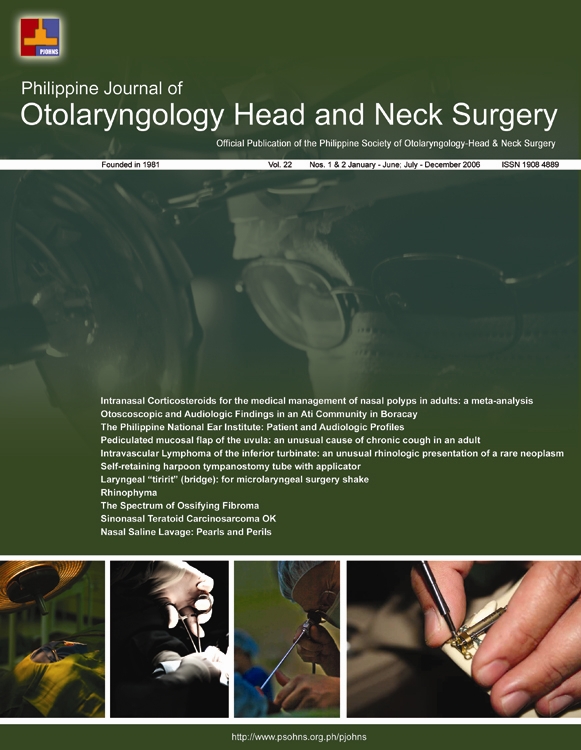Intranasal Corticosteroids for the Medical Management of Nasal Polyps in Adults: a Meta-Analysis
DOI:
https://doi.org/10.32412/pjohns.v22i1-2.787Keywords:
polyp, nose, steroids, intranasal steroids, glucocorticosteroidAbstract
Background: This systematic review aims to strengthen evidence of beneficial effects of intranasal corticosteroids on the medical treatment of adults diagnosed with nasal polyps.
Objectives: (1) To determine the efficacy of short term (2 to 4 weeks) and long term (4 to 12 weeks and > 12 weeks) of intranasal corticosteroids in the reduction of polyp size and rhinitis symptoms. (2). To determine the difference in efficacy of a 400 ug and 800 ug dose. (3) To determine adverse effects of intranasal steroids.
Study Design and Selection Criteria: Meta-analysis of randomized controlled trials on intranasal steroids for nasal polyps. Patient-oriented outcomes were reduction of polyp size and overall reduction of rhinitis symptoms.
Search Strategy: Comprehensive search of Cochrane's Controlled Trials Registry (CCTR) Issue 2, 2003, Medline 1966 to 2002, and Embase 1974 - 2002 bibliographic review, requests for information from authors and pharmaceutical companies.
Data collection and analysis: Sixteen studies were evaluated for inclusion, and trial quality, validity assessment, and completion of data extraction were done. Ordinal data on rhinitis and polyp scores for each study were pooled to generate relative risks. Homogeneity was assessed using approximate chi-square tests. Preset p value of < 0.10 was deemed significant for heterogeneity. Data were analyzed using software program Revman 4.1(Update Software, Oxford). Sensitivity analysis was done for those outcomes with significant heterogeneity.
Results and Conclusion: Fourteen studies found significant benefit for the use of intranasal steroids in reduction of polyp size with 2-4 weeks treatment (RR=3.00; 95% Cl: 2.39, 3.77).
Overall rhinitis symptoms decreased significantly (RR=1.64; 95% Cl: 1.25, 2.14) with 4-12 weeks treatment, with a tendency for reduction of rhinitis symptoms (RR=1.41; 95% Cl: 1.05, 1.91) with more than 12 weeks treatment. Throat irritation was significantly increased (RR=2.06; 95% Cl 1.31, 3.25). There was no difference in overall rhinitis symptoms (RR=0.91; 95% Cl:0.77, 1.07) with 400 ug and 800 ug doses.
Keywords: polyp, nose, steroids, intranasal steroids, glucocorticosteroid
Downloads
Published
How to Cite
Issue
Section
License
Copyright transfer (all authors; where the work is not protected by a copyright act e.g. US federal employment at the time of manuscript preparation, and there is no copyright of which ownership can be transferred, a separate statement is hereby submitted by each concerned author). In consideration of the action taken by the Philippine Journal of Otolaryngology Head and Neck Surgery in reviewing and editing this manuscript, I hereby assign, transfer and convey all rights, title and interest in the work, including copyright ownership, to the Philippine Society of Otolaryngology Head and Neck Surgery, Inc. (PSOHNS) in the event that this work is published by the PSOHNS. In making this assignment of ownership, I understand that all accepted manuscripts become the permanent property of the PSOHNS and may not be published elsewhere without written permission from the PSOHNS unless shared under the terms of a Creative Commons Attribution-NonCommercial-NoDerivatives 4.0 International (CC BY-NC-ND 4.0) license.



